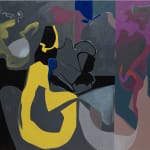A Shifting Sort Of Seeming: The Pleasurable Difficulty Of Leopold Plotek
by Benjamin Klein
Painting seriously over a prolonged period of time, as Leopold Plotek has done both, is a stranger thing than it seems, requiring both dogged consistency and renewed notions and methods. The fact is that in order for an artistic idea or motif to become a strong painting, no matter how interesting it may seem, there has to be a good reason for the hand to do it. This is something Plotek has emphasized in his conversations. Otherwise, with all the various technical and technological options artists have at their disposal, there's a risk that painting- especially in the age-old form of oil on canvas- will turn an interesting conceit into a reduced experience, or, at the least, something that didn't need to be a painting. But when for internal, and perhaps unknowable, reasons artists need to paint their ideas, oil paint provides a unique expressive vehicle. Plotek's paintings are some of the best examples in Canada, and maybe anywhere, of a painter who uses the medium comprehensively.
Visually speaking, the deployment of bold, irregular, lyrical shapes set in stark contrast and dark overall tonalities made to vibrate by using passages of high-intensity hue, have been constant features of Plotek's work. His paintings are orchestral and sonorous, controlled but expansive, and they glister with rich, glossy surfaces that glow softly with a warm seemingly internal light. Plotek has been in constant aesthetic development over time, pushing the stylistic elements he began with when he started to work in oil on canvas in the late 1970s. Initially, his compositions were worked up from memories and sketches done in Italy of churches and other buildings, which were later used to conjure a composition and unfetter his procedure, marrying a broad toolbox of modernist techniques with a deep, exploratory process. Over time he began to work from a range of subjects, and draw from a large field of influences, with postmodern examples all taken into equal consideration and used, as well, in juxtaposition to modulate any excessive stylistic overdetermination. Even though many reference points are present in the paintings, Plotek's work doesn't look very much like anyone else's.


